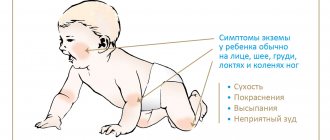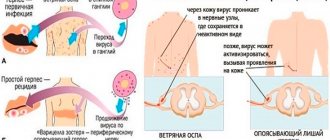Pediatrician
Stepanova
Olga Evgenievna
32 years of experience
Pediatrician of the highest category, member of the Union of Pediatricians of Russia
Make an appointment
A common pathology among newborns and children in the first years of life, which is based on a lack of minerals for the formation of bone tissue, is called rickets. It is considered a growing disease because it mainly affects children between two months and three years of age. In one form or another (mostly mild), it is diagnosed in 55-65% of full-term newborns in our country, and among premature infants its number reaches 80%. Pediatricians note that two or three mild signs of the disease are present in many children up to three to four months of age, but subsequently they disappear without any treatment.
Why does the disease develop?
The main cause of rickets in children is a lack of vitamin D. This substance performs two important functions: it helps the absorption of calcium in the small intestine and reduces its leaching in the kidneys. Vitamin D comes in small quantities from food, but its main share (up to 80%) is produced in the layers of the epidermis under the influence of solar ultraviolet radiation. Vitamin D comes through the intestines in an inactive form, and to participate in calcium metabolism it must be activated by passing through the liver and kidneys.
Most often, signs of rickets are observed in children living in large cities with unfavorable environmental conditions, where it is difficult to find a suitable area for daily walks with the child. In dysfunctional and low-income families, children with this pathology are more common than in families that do not experience financial difficulties. In addition, risk factors are:
- mother’s age: either too young (under 18 years old) or mature (after 40 years old);
- limited maternal exposure during pregnancy;
- insufficient nutrition of the mother during pregnancy, unreasonable dieting, lack of physical activity;
- chronic maternal illnesses;
- third and subsequent pregnancies;
- premature pregnancy;
- birth of twins;
- frequent births (less than two years between births);
- artificial feeding of a child with incomplete absorption of necessary substances from the nutritional mixture;
- incorrect nutritional choices that are not appropriate for the child’s age;
- underfeeding or overfeeding;
- intrauterine development disorders;
- diseases of the nervous system;
- digestive disorders, insufficient absorption of nutrients in the intestines.
Boys suffer from rickets more often than girls, dark-skinned children more often than light-skinned children. In addition, the child’s second blood group is an additional risk factor.
How to recognize the disease
Most external signs of rickets are not specific, i.e. they can signal different diseases. Until the age of three months, it practically does not appear, and quite distinct symptoms are formed no earlier than in the second half of the year. Parents should be wary if their child:
- becomes nervous, frightened by sharp sounds or flashes of a switched-on lamp;
- sweats profusely, and the scalp often becomes moist, sticky sweat with a sour smell irritates the skin and causes itching, the child often scratches his head;
- muscle tone is reduced, so the child is delayed in physical development - later than peers, he begins to sit, crawl and stand on his feet;
- when palpated, a large fontanel with soft edges is felt.
In severe forms of the disease, symptoms of rickets in children manifest themselves in the form of deformation of bone tissue. In a sick child:
- legs are bent, knees are turned outward or brought together;
- sunken sternum;
- flattened nape;
- The parietal and frontal tubercles protrude, bald patches appear on the forehead;
- For a long time, teeth do not erupt and the fontanel does not close.
The disease affects the activity of internal organs, which manifests itself as:
- periodic seizures;
- digestive dysfunction, stool instability, decreased weight;
- anemia;
- reduced immunity, frequent colds and respiratory infections.
The listed symptoms may indicate not only rickets, but also a number of other diseases, so laboratory tests are necessary to confirm the diagnosis.
Are you experiencing symptoms of rickets?
Only a doctor can accurately diagnose the disease. Don't delay your consultation - call
Postnatal prevention in the 1st – 2nd year of life
Postnatal prevention of rickets is not limited to the first year of a child’s life. The need of a child's body for vitamin D exceeds that of adults. This can be easily explained by the active growth of the musculoskeletal system and the development of internal organs, intensive consumption of organic and mineral food components. It is generally accepted that a healthy child needs vitamin D supplementation up to 4 years of age. The preventive dosage of the drug for a healthy child is on average 500-1000 IU per day. Dose adjustment is carried out in the presence of risk factors for hypovitaminosis. Children born prematurely, children from multiple pregnancies, children with low height and weight, children with diagnosed pathology or morpho-functional immaturity - they should all receive a larger dose of the drug.
Therapy for already developed rickets is prescribed taking into account the degree of bone damage and varies from 2000 to 5000 IU per day. The course of therapy must be limited. And also, calcium-phosphorus metabolism is controlled by monitoring biochemical blood parameters.
Do not forget that each case is unique and requires an individual approach. This is exactly how specialists at the CELT multidisciplinary clinic work. Contact us for a consultation and we will help you raise a strong and healthy baby!
Make an appointment through the application or by calling +7 +7 We work every day:
- Monday—Friday: 8.00—20.00
- Saturday: 8.00–18.00
- Sunday is a day off
The nearest metro and MCC stations to the clinic:
- Highway of Enthusiasts or Perovo
- Partisan
- Enthusiast Highway
Driving directions
How is rickets treated in children?
Currently, the treatment of rickets is complex. It includes:
- organizing a daily routine with daily long walks in the fresh air;
- providing adequate nutrition that satisfies the child’s need for calcium and other minerals;
- drug therapy - taking vitamin D in a dosage sufficient to compensate for the deficiency;
- non-drug therapy - massage, therapeutic exercises, ultraviolet baths, balneotherapy.
If clinical recommendations are followed, rickets is cured quickly enough and without long-term consequences, but only if measures were taken in the initial stages of the disease. In severe forms of the disease, it is not always possible to overcome skeletal deformation; delays in physical development, as well as the negative impact of the disease on the nervous system, are not without consequences. For three years after recovery, the child remains under clinical supervision with quarterly medical examinations.
Rickets: symptoms and treatment
Rickets is a childhood disease at the stage of active skeletal growth, in which characteristic developmental disorders of the musculoskeletal system occur. It occurs against the background of a lack of vitamin D in the body, which causes disturbances in the metabolism of calcium and phosphorus and deforms the bones.
Rickets does not pose a threat to the life of the child, but causes irreversible deformations of the skeletal bones, and also provokes inhibition of many child development processes. First of all, this applies to the physical and psychological state of the child; against the background of rickets, the risk of developing many diseases also increases. For this reason, the prevention of rickets is one of the most important tasks of modern pediatrics.
Exact statistics on the appearance of rickets have not been established, but many young patients exhibit certain residual effects of the disease: abnormalities in tooth growth, malocclusion, deformations of the skull, chest, and lower extremities.
In fact, rickets is not an isolated disease, but a whole group of diseases and metabolic disorders that have a common feature - a decrease in the level of calcium in bone tissue, which leads to osteopenia. Pathology can be caused not only by vitamin D deficiency, but also by other established external and internal factors.
Rickets is often called a disease of active growth, due to its specific manifestations. It occurs at the stage of increased skeletal growth in a small child, when an imbalance forms in the body between incoming calcium and vitamin D on the one hand and their consumption on the other.
Hypovitaminosis D is the insufficient formation of this vitamin in the skin under the influence of ultraviolet radiation. Normally, the vitamin accumulates in the skin (in the form of tanning), adipose tissue, and liver muscles. These reserves are consumed in the cold season, when exposure to the sun is limited and the skin is covered with clothing.
The body's need for vitamin D is dictated in each individual case individually and depends on many factors: skin color type, age, solar activity in the region, etc. Children require the most vitamin during the first years of life, which will ensure the correct formation of bone tissue in the future; the average norm is 55 mg of the substance per 1 kg of the child’s weight.
With age, the body's need for the vitamin decreases as the skeleton develops. In adults, the normal level is considered to be 8 mg of the substance per 1 kg of weight.
Causes of rickets
- Prematurity. In the last months of pregnancy, the fetus receives the maximum amount of calcium and phosphorus, so premature babies are at risk of developing rickets with a probability of up to 80%.
- Improper feeding. The risk group includes children who are artificially or irrationally fed, in which the body receives an insufficient amount of calcium and phosphorus, vitamin A, B, microelements with food, with a monotonous protein or lipid diet.
- Lack of minerals caused by their increased need during the period of intensive growth of the body.
- Disruption of the transport of calcium and phosphorus in the gastrointestinal tract, kidneys and bones, which is caused by the immaturity of enzyme systems, developmental pathologies or disturbances in the functioning of these organs.
- Ecological features when the environment contains an excess of chromium, iron, strontium, lead salts or, conversely, a deficiency of magnesium is detected.
- Sexual characteristics. According to statistics, boys are more predisposed to the development of rickets, and they also suffer from it more severely than girls.
- Vitamin D deficiency.
- Endocrine disorders, such as damage to the thyroid or parathyroid glands.
- Genetic predisposition.
Classification of the disease
Depending on changes in the concentration of phosphorus and calcium in the blood serum:
- calciumpenic – with a lack of calcium;
- phosphopenic – with a lack of phosphorus;
- without significant changes in calcium and phosphorus levels.
Rickets with specific features of the course:
- Acute - with a predominance of neurological symptoms and manifestations of osteomalacia, a systemic disease in which bone tissue is insufficiently mineralized. The main symptoms of osteomalacia: bone pain, muscle hypotonia (reduced muscle tone due to impaired muscle strength), malnutrition (mass deficiency with a decrease in the thickness of the subcutaneous fat layer), deformation of skeletal bones, the formation of pathological fractures.
- Subacute – with a predominance of symptoms of osteoid hyperplasia, a condition in which osteoid tissue rapidly grows. The main symptoms: parietal and frontal tubercles, thickenings in the wrist area - “rachitic bracelets”, thickenings at the transition points of the bony part into the cartilaginous part on the ribs - “rachitic rosaries”, thickening of the phalangeal joints of the fingers - “strings of pearls”.
- Wavy or recurrent - gradual or sharp return of the acute form of rickets.
Depending on the severity of the manifestations:
- I degree – mild with mild symptoms.
- II degree – moderate with moderately severe symptoms affecting internal organs and the skeletal system.
- III degree – severe with simultaneous damage to several parts of the skeletal system, serious disturbances in the functioning of internal organs and the nervous system, delay in physical and/or mental development, which is caused by compression of the brain by improperly formed bones of the skull.
According to the cyclicity of the course:
- Initial period.
- The height of the disease.
- Period of convalescence or reparation.
- Period of residual effects.
According to the characteristics of occurrence:
- Primary rickets.
- Secondary, caused by the action of provoking diseases. These include malabsorption syndromes (impaired absorption of nutrients in the intestines); chronic diseases of the biliary tract or kidneys; metabolic disorders (tyrosinemia, cystinuria, etc.); long-term use of anticonvulsants, glucocorticosteroids, diuretics; intravenous nutrition.
Main symptoms
The symptoms of the disease depend on its period.
Initial period
As a rule, the first symptoms of the initial period of rickets appear in the first 3 months of the baby’s life. The child has:
- Increased fearfulness, anxiety and excitability when exposed to external stimuli, for example, sudden noise, flashes of light.
- Anxiety in sleep, its superficiality.
- Increased sweating with a characteristic sour odor, especially noticeable on the face and scalp.
- Itching of the skin in the area of increased sweating, which leads to the child’s desire to scratch his head on the pillow, and subsequent baldness in the areas of friction.
- The characteristic muscle hypertonicity turns into muscle hypotonia (muscle flaccidity).
- The sutures of the skull and the edges of the large fontanelle become pliable, and thickenings form in the area of the costochondral joints.
- An x-ray may reveal slight loss of bone tissue.
- Blood biochemistry shows normal or elevated calcium levels with decreased phosphate levels.
The height of the disease
The beginning of this period, as a rule, begins in the second half of the baby’s life, when disturbances in the development of the musculoskeletal system and the functioning of the nervous system become more and more pronounced:
- The flat bones of the skull soften due to the processes of osteomalacia.
- A unilateral thickening of the back of the head is formed.
- A saddle nose may develop due to the retraction of the bridge of the nose.
- The head seems too big compared to the body.
- The chest is deformed, for example, the lower third of the sternum is depressed, which is called the “shoemaker's chest,” or protrudes, called the “chicken” or “keeled” chest. As it worsens, a depression is formed along the entire line of the diaphragm - the “Harrison groove”.
- A narrowed flat-rachitic pelvis is formed.
- The bones of the legs are curved in an O-shape; their X-shape is much less common.
- Subsequent hyperplasia of osteoid tissues of the subacute period is manifested by parietal and frontal tubercles, thickening of the costochondral joints, phalangeal joints of the fingers, and wrists.
Convalescence
During this period, the child’s condition improves: static functions are normalized, the level of phosphates in the blood increases and may even slightly exceed the norm, while the calcium deficiency is insignificant.
Residual effects
At this stage, the child’s blood biochemistry almost returns to normal, and the symptoms of the active stage of rickets disappear. However, skeletal deformities and muscle hypotonia persist for a long time.
Muscle symptoms of rickets
- “Frog belly”, which appears due to weakening of the muscle tone of the anterior abdominal wall.
- The child begins to walk much later than his peers due to pliability and looseness of the joints.
- Difficulty maintaining the body in an upright position.
Consequences for internal organs
- Disruption of the gastrointestinal tract, liver, and spleen due to a lack of calcium and vitamin D. Children with rickets are characterized by anemia, constipation, and yellowness of the skin.
- The normal functioning and growth of internal organs is disrupted due to deformation of the chest frame. This leads to frequent diseases, for example, when the lungs are compressed - to colds and bronchopulmonary diseases, when the heart is compressed - to heart failure.
- Delayed closure of the fontanel on the head.
- Late teething, formation of malocclusion.
- Weakness of the ligamentous apparatus leads to the fact that children with this disease begin to hold their heads, sit up and walk much later.
Diagnostics
The disease is diagnosed based on a biochemical blood test, which shows changes in the levels of calcium, phosphorus and phosphatase over time. Their ratio allows us to determine the period of the disease.
The diagnosis is also made based on a visual examination of the patient.
Treatment of rickets
The treatment tactics for the disease are selected depending on the period of its occurrence and severity; it is based on:
- Vitamin D preparations.
- A balanced diet rich in vitamins.
- Correct wakefulness and sleep patterns.
- Sufficient or prolonged exposure to fresh air.
- Therapeutic exercises to correct bone deformities and increase muscle tone.
- Massage and passive gymnastics for the youngest children.
- Salt, pine baths.
- Sunbathing.
- Ultraviolet irradiation.
- Calcium preparations for hypocalcemia are supplemented with a citrate mixture to improve its absorption.
The prognosis for treatment of rickets is in most cases favorable if the disease occurs in the classical form. Lack of or improper treatment leads to irreversible deformations and disturbances in the functioning of internal organs, and delayed physical and mental development.
Disease prevention
Prevention helps prevent rickets, which begins even before the birth of the child. It includes:
- Saturating a pregnant woman’s diet with vitamins, especially vitamin D, and taking vitamin and mineral complexes.
- Enough time for women to spend time in the fresh air.
- On the recommendation of an observing specialist, it is possible to take vitamin D in prophylactic doses from the 32nd week of pregnancy.
- In higher doses, vitamin D is prescribed to women who are at risk due to diseases of the kidneys, liver, thyroid and parathyroid glands.
- Prevention of infectious diseases and colds during pregnancy.
- Prevention of premature babies.
At the same time, exceeding the required dose of vitamin D can cause calcium deposition in the placenta and complications during pregnancy.
Prevention in the postpartum period begins from the first days after the birth of the baby:
- Long walks in the fresh air.
- In the warm season, sunbathing in moderation is necessary; for prevention, it is enough to keep the baby’s arms and legs open. The duration of solar procedures starts from 3-5 minutes, gradually increasing them to half an hour.
- Air baths at a comfortable temperature and without drafts.
- Breastfeeding during the first year of life. If it is absent, use a properly selected adapted mixture.
- Rational introduction of complementary foods, the basis of which should be cereals, vegetables, and fruits. Flour products and sweets are excluded whenever possible.
As a specific prevention, vitamin D is prescribed to children in the first two years of life, especially to babies born in the autumn-winter period with reduced natural insolation.
During sunny, warm months, medications are stopped. Author: K.M.N., Academician of the Russian Academy of Medical Sciences M.A. Bobyr
FAQ
Does rickets occur in breastfed children?
Yes, a baby whose mother is breastfeeding may develop rickets if the mother's diet or lifestyle does not provide her body with enough of this vitamin. Therefore, pediatricians prescribe vitamin D preparations prophylactically to all children, including those who are breastfed.
What are the consequences of rickets?
The most severe consequences of the disease are skeletal deformities, including:
- incorrect bite and, as a result, difficulty chewing, impaired diction, jaw deformation, caries;
- rachiocampsis;
- curvature of the pelvis, especially dangerous for girls;
- mental deficiency due to cranial deformation.
These are just some of the adverse effects. Therefore, even with minor symptoms of rickets, the child should be shown to a doctor.
Does a child need to take calcium with rickets?
The need to prescribe calcium supplements becomes clear from the results of laboratory tests. With severe hypocalcemia, the child may need pharmaceutical drugs, which must be combined with an increase in the proportion of calcium-rich foods in the diet - dairy products, legumes, almonds and pistachios.









